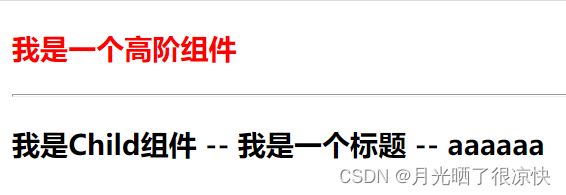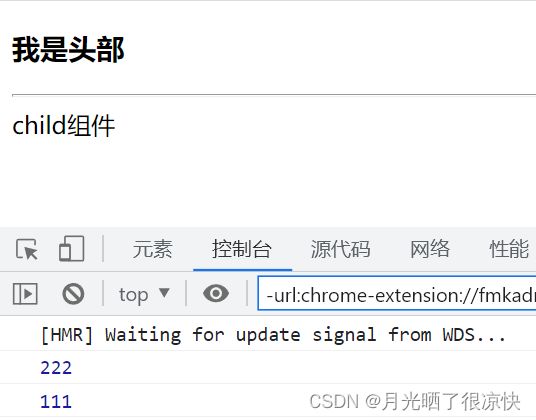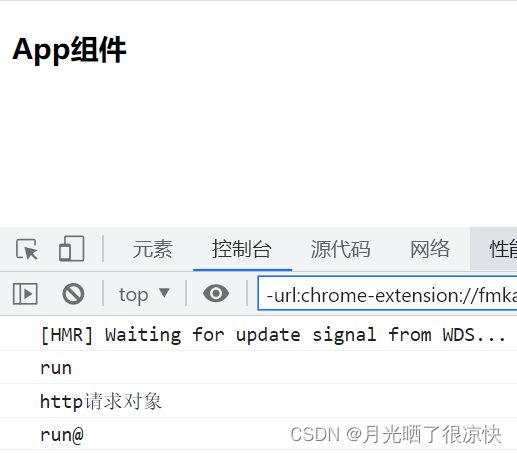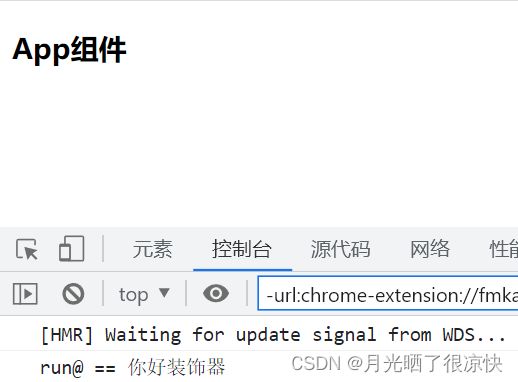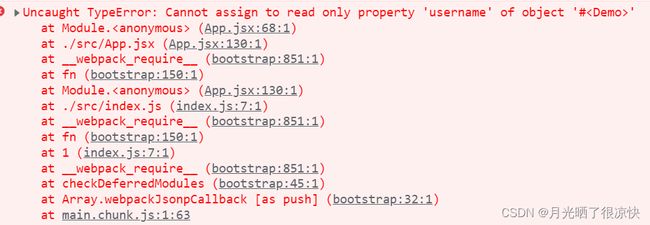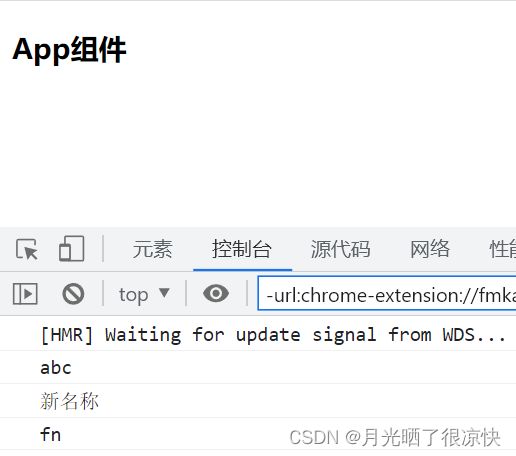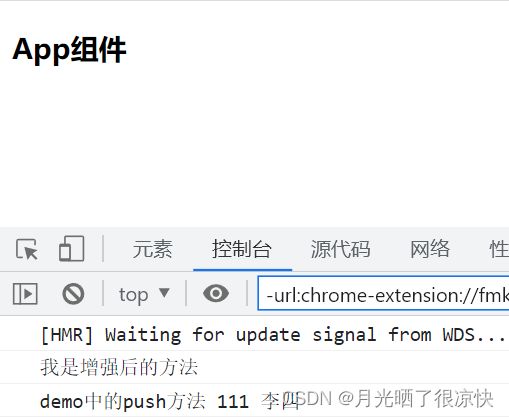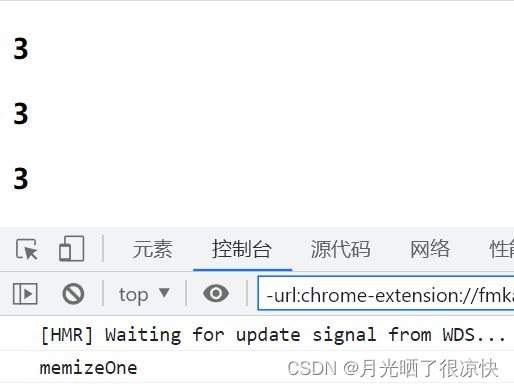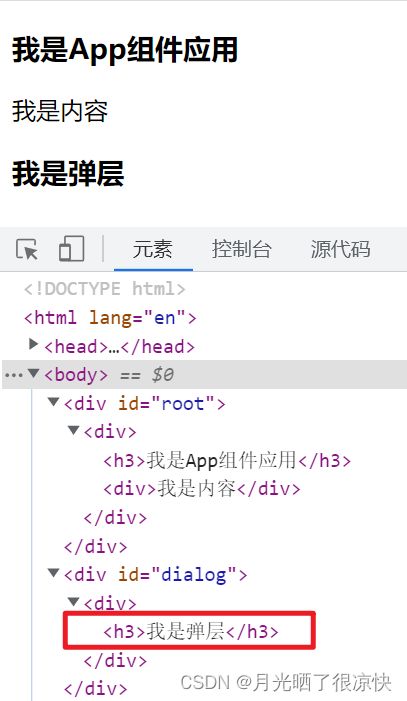React高阶组件
文章目录
- 1. 介绍
- 2. 高阶组件的定义和使用
- 3. 装饰器
-
- 3.1 装饰器调用高阶函数
- 3.2 装饰器装饰类
- 3.3 装饰器装饰成员属性
- 3.4 装饰器装饰成员方法
- 4. 高阶组件反向继承
- 5. memoization(计算属性/记忆组件)
- 6. Portals
1. 介绍
高阶组件 (Higher-Order Components) 就是一个函数,传给它一个组件,它返回一个新的组件。
高阶组件:就相当于手机壳,通过包装组件,增强组件功能。
实现步骤:
- 创建一个函数
- 指定函数参数,参数应该以大写字母开头
- 在此函数内部创建一个类组件或函数组件
高阶组件常见作用:
- 进行权限控制
- 路由限制
- 访问统计
- 统一布局
缺点:增加了组件层级,影响性能
2. 高阶组件的定义和使用
定义高阶组件:
// 定义高阶组件,用来进行全局布局
import React from 'react'
import _ from 'lodash'
// 1.它就是一个函数
// 2.参数首字母大写,因为你传入的是一个组件,在react中组件的调用必须首字母大写
// 3.返回一个组件
// 写法1
const withLayout = Cmp => {
class Layout extends React.Component {
render() {
// 方案1
// let phone = this.props.phone
// phone = 'xxxxx'
// 方案2:深复制
let props = _.cloneDeep(this.props)
props.phone = 'aaaaaa'
// console.log(this.props);
return <div>
<h3 style={{ color: 'red' }}>我是一个高阶组件</h3>
<hr />
{/* 我是一个高阶组件
//
// 我是一个高阶组件
//
// 我是一个高阶组件
//
// 我是一个高阶组件
//
// 父组件:
import React, { Component } from 'react'
import Child from './pages/Child'
class App extends Component {
render() {
return (
<div>
<Child title="我是一个标题" phone="13523253252" />
</div>
)
}
}
export default App
子组件:
import React, { Component } from 'react'
import withLayout from '../../hoc/withLayout'
class Child extends Component {
render() {
return (
<div>
<h3>
我是Child组件 -- {this.props.title} -- {this.props.phone}
</h3>
</div>
)
}
}
export default withLayout(Child)
3. 装饰器
概述:
装饰器是用来装饰类的,可以增强类,在不修改类的内部的源码的同时,增强它的能力(即装饰器会增加类的属性和方法)。
装饰器使用@函数名写法,对类进行装饰,目前在js中还是提案,使用需要配置相关兼容代码库。react脚手架创建的项目默认是不支持装饰器,需要手动安装相关模块和添加配置文件。
使用前准备:
-
安装解析装饰器语法的模块
yarn add -D @babel/plugin-proposal-decorators -
安装配置相关兼容代码的模块
yarn add -D customize-cra react-app-rewired -
修改package.json文件中scripts命令
"scripts": { "start": "react-app-rewired start", "build": "react-app-rewired build", "test": "react-scripts test", "eject": "react-scripts eject" } -
在项目根目录中添加config-overrides.js配置文件
此文件可以理解为就是webpack.config.js的扩展文件
// 增量配置当前项目中的webpack配置,建议在react18中不要用 // 建议在react18中也不要用装饰器 // override 方法,如果webpack中有此配置则,覆盖,如果没有则添加 const { addDecoratorsLegacy, override } = require('customize-cra') // 追加上一个装饰器 module.exports = override(addDecoratorsLegacy()) -
修改配置文件后,需要重启服务
3.1 装饰器调用高阶函数
对上文中书写的子组件(高阶函数的部分)进行修改:
import React, { Component } from 'react'
import withLayout from '../../hoc/withLayout'
// @装饰器 对这个类进行修改 装饰器只能装饰类
// 装饰器特性它还没有正式的在js规范中,所以需要来添加js解析器来解析这样的语法
// yarn eject 弹开webpack配置,添加 babel的plugins配置
// 增量配置 @craco/craco进行增量配置=>配置webpack 或 customize-cra react-app-rewired
@withLayout
class Child extends Component {
render() {
return (
<div>
<h3>
我是Child组件 -- {this.props.title} -- {this.props.phone}
</h3>
</div>
)
}
}
// export default withLayout(Child)
export default Child
高阶函数的执行顺序:
App.jsx:
import React, { Component } from 'react'
import Child from './components/Child-02-装饰器调用高阶组件'
class App extends Component {
render() {
return (
<div>
<Child />
</div>
)
}
}
export default App
Child.jsx:
import React, { Component } from 'react'
import withLayout from '../hoc/withLayout'
const fn1 = target => {
console.log(111)
}
const fn2 = target => {
console.log(222)
}
// 装饰器,装饰一个类,可以写N多个,执行的顺序为 从下向上,从右向左
@fn1 @fn2 @withLayout
class Child extends Component {
render() {
return (
<div>
<div>child组件</div>
</div>
)
}
}
// export default fn1(fn2(withLayout(Child)))
export default Child
3.2 装饰器装饰类
有两种写法。
写法1(装饰器装饰类的函数,不使用小括号):
import React, { Component } from 'react'
// 装饰器 用来装饰类的,可以增强类,在不修改类的内部的源码的同时,增强它的能力(属性或方法)
// 函数
// 装饰器写法,和vue中的 use 插件是很一样
// 装饰函数,在装饰时它没有写小括号
// target它就是当前你装饰的类(demo)
const handle = target => {
// console.log(target)
// 定义一个静态方法,不是成员方法,无法通过实例来调用
target.run = () => console.log('run')// Demo.run()
// 成员属性
target.prototype.$http = 'http请求对象'
// 成员方法
target.prototype.run = function () {
console.log('run@')
}
}
@handle
class Demo { }
Demo.run()
const d = new Demo()
console.log(d.$http);
d.run()
class App extends Component {
render() {
return (
<div>
<h3>App组件</h3>
</div>
)
}
}
export default App
写法2(装饰器装饰类的函数,使用小括号):
import React, { Component } from 'react'
// 装饰器装饰的类的函数使用了小括号,则定义函数时一定要返回一个新函数
// target它就是当前你装饰的类(demo)
const handle = msg => target => {
// 成员方法
target.prototype.run = function () {
console.log('run@ ==', msg)
}
}
@handle('你好装饰器')
class Demo {}
const d = new Demo()
d.run()
class App extends Component {
render() {
return (
<div>
<h3>App组件</h3>
</div>
)
}
}
export default App
3.3 装饰器装饰成员属性
装饰器可以修改成员属性的描述:
// 装饰器装饰成员属性,装饰时没有写小括号
// target 装饰的类的实例 new Demo this
// key 当前的成员属性名称 username
// description 就是当前属性在对象中它的描述 Object.defineProperty
const handle = (target, key, description) => {
// 装饰器可以修改描述
return {
...description,
// 设置当前属性为只读属性
writable: false
}
// target[key] = 'vvv'
}
class Demo {
@handle
username = 'abc'
}
const d = new Demo()
d.username='vvv'
console.log(d.username)
装饰器可以添加新的成员属性:
import React, { Component } from 'react'
// 成员属性不能重置值,但可以修改属性描述
// 在给成员属性添加装饰时,可以动态的来添加别的成员属性或方法
const handle = name => (target, key, description) => {
// console.log(target, key, description)
// 添加新的属性值
target.name = name
target.fn = function () {
console.log('fn')
}
}
class Demo {
// 可以装饰属性,可读可写设置(readonly),可被迭代(in),可被删除(delete)
@handle('新名称')
username = 'abc'
}
const d = new Demo()
console.log(d.username)
console.log(d.name)
d.fn()
class App extends Component {
render() {
return (
<div>
<h3>App组件</h3>
</div>
)
}
}
export default App
3.4 装饰器装饰成员方法
import React, { Component } from 'react'
const handle = name => (target, key, description) => {
// 原对象中的方法
let oldFn = description.value
description.value = function (...arg) {
console.log('我是增强后的方法')
// 解决了this指向,会了两种在调用时解决this指向问题的方案
// oldFn.call(this, ...arg)
// this 指向调用函数的对象
oldFn.apply(this, arg)
}
}
class Demo {
username = '李四'
@handle('张三')
push(arg) {
console.log('demo中的push方法', arg, this.username)
}
}
const d = new Demo()
d.push('111')
class App extends Component {
render() {
return (
<div>
<h3>App组件</h3>
</div>
)
}
}
export default App
4. 高阶组件反向继承
描述:
通过创建新组件继承自原始组件, 把原始组件作为父组件。
作用:可以渲染劫持或是操作 state 数据。
使用:
App.jsx:
import React, { Component } from 'react'
import Child from './components/Child-03-反向继承'
// Child组件,可以理解为是第3方组件,但是这个组件它功能可能不全,需要增强
class App extends Component {
render() {
return (
<div>
<Child>你好世界</Child>
</div>
)
}
}
export default App
Child.jsx:
import React, { Component } from 'react'
import withCmp from '../hoc/withCmp'
@withCmp
class Child extends Component {
state = {
id: 1
}
render() {
return (
<div>
<button></button>
</div>
)
}
}
export default Child
定义高阶组件(withCmp.js):
import React, { Component } from 'react';
// 高阶组件的反向继承,来扩展原组件中的页面结构或方法
export default Cmp => {
return class extends Cmp {
render() {
// let ele = React.cloneElement(super.render().props.children, {}, '值')
let ele = React.cloneElement(super.render().props.children, {}, this.props.children)
return (
<div>
<h3>{this.state.id}</h3>
{ele}
</div>
);
}
}
}
5. memoization(计算属性/记忆组件)
描述:
连续两次相同传参,第二次会直接返回上次的结果,每次传参不一样,就直接调用函数返回新的结果,会丢失之前的记录,并不是完全记忆,可以在它的参数中传入 state 数据从而实现了类似 Vue 中的计算属性功能。
语法:
# 安装
npm i -S memoize-one
# 引入
import memoizeOne from 'memoize-one'
# 使用
getValue = memoizeOne((x,y) => x+y)
# 调用
render(){
let total = this.getValue(this.state.x, this.state.y)
return <div>{total}</div>
}
使用:
import React, { Component } from 'react'
// 用于计算所用,在类组件中,需要安装,在函数组件中它内置
// 此方法是一个性能优化的方案,可以不用,但是如果有计算且多次调用,则建议使用
import memizeOne from 'memoize-one'
class App extends Component {
state = {
n1: 1,
n2: 2
}
// n1和n2参数就是它的依赖项,只要它的依赖项没有变化,则第2次后调用都为缓存中读取
sum = memizeOne((n1, n2) => {
console.log('memizeOne')
return n1 + n2
})
render() {
let { n1, n2 } = this.state
return (
<div>
<h3>{this.sum(n1, n2)}</h3>
<h3>{this.sum(n1, n2)}</h3>
<h3>{this.sum(n1, n2)}</h3>
</div>
)
}
}
export default App
6. Portals
描述:
Portal 提供了一种将子节点渲染到存在于父组件以外的 DOM 节点的优秀的方案。
使用:
App.jsx:
import React, { Component } from 'react'
import Child from './components/Child-05-portal指定html挂载点显示'
class App extends Component {
render() {
return (
<div>
<h3>我是App组件应用</h3>
<Child />
<div>我是内容</div>
</div>
)
}
}
export default App
child.jsx:
import React, { Component } from 'react'
// 引入相关库
import { createPortal } from 'react-dom'
class Child extends Component {
render() {
return createPortal(
<div>
<h3>我是弹层</h3>
</div>,
document.getElementById('dialog')
)
}
}
export default Child
public/index.html:
DOCTYPE html>
<html lang="en">
<head>
<meta charset="utf-8" />
<meta name="viewport" content="width=device-width, initial-scale=1" />
<title>React学习title>
head>
<body>
<div id="root">div>
<div id="dialog">div>
body>
html>
案例——弹出层的实现:
App.jsx:
import React, { Component } from 'react'
import Child from './components/Child-06-portals实现弹出层'
class App extends Component {
state = {
isshow: true
}
render() {
return (
<div>
<h3>我是App组件应用</h3>
{this.state.isshow ? <Child /> : null}
<div>我是内容</div>
<hr />
<button
onClick={() => {
this.setState(state => ({ isshow: !state.isshow }))
}}
>
++++
</button>
</div>
)
}
}
export default App
Child.jsx:
import React, { Component } from 'react'
import { createPortal } from 'react-dom'
const createDialog = () => {
const el = document.createElement('div')
el.id = 'dialog'
el.style.cssText = `
position: absolute;
top: 0;
width: 100%;
min-height: 100vh;
background: rgba(0, 0, 0, 0.6);
color: #fff;
font-size: 30px;
display: flex;
justify-content: center;
align-items: center;`
document.body.appendChild(el)
// 要把对象和销毁方法返回出去,这样别人才能使用
return [el, () => el.remove()]
}
class Child extends Component {
// 方案1
// el = document.createElement('div')
// componentDidMount() {
// document.body.appendChild(this.el)
// }
// componentWillUnmount() {
// this.el.remove()
// }
// 方案2
el = createDialog()
componentDidMount() {
this.timer = setTimeout(this.el[1], 3000)
}
componentWillUnmount() {
this.el[1]()
this.timer && clearTimeout(this.timer)
}
render() {
return createPortal(
<div>
<h3>我是弹层@</h3>
</div>,
this.el[0]
)
}
}
export default Child
